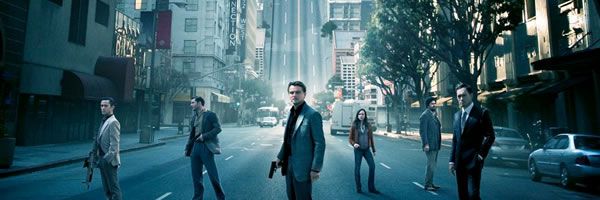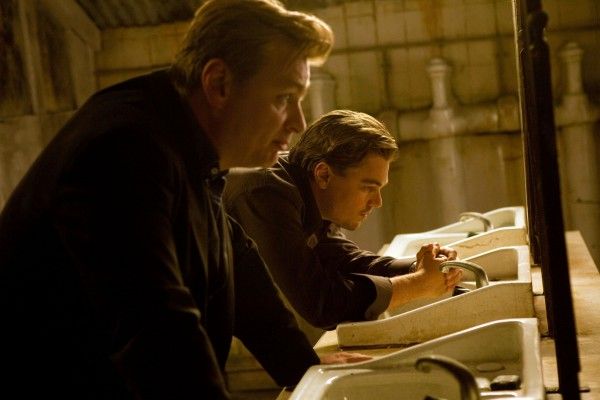Christopher Nolan’s Inception came across as the man’s payout for having directed The Dark Knight, a film that grossed a billion dollars worldwide, recharged the franchise, and is inarguably one of the best superhero movies ever made. His follow-up brought in Leonardo Di Caprio to play Cobb, who works as an “extractor.” His profession is corporate espionage, stealing secrets from successful men through their dreams. Structured in some ways like a heist film (in others like a Bond movie), Cobb is given a “one last mission” situation where instead of stealing, he has to give someone an idea in their dreams. This situation will allow him to finally go home to his family. Supported by the likes of Tom Hardy, Joseph Gordon-Levitt, Ellen Page, Ken Watanabe and Dileep Rao, he’s got a team to take on the hardest job he’s ever done. My review of the Inception Blu-ray follows after the jump.
The film starts with a flash-forward, where Cobb is found on a beach, and meets an old wrinkled Japanese man, then flashes back to find Cobb pitching Saito (Watanabe) about dream security. There it’s revealed he’s working with Arthur (Gordon-Levitt) and is trying to take something from Saito. There he also meets Mal (Marion Cottilard), who is his dead wife and is always working against him in his dreams. When Saito, Arthur and Cobb wake up they’re in an apartment with Nash (Lukas Haas), but there it’s revealed that the last dream was a dream within a dream, and the apartment they’re in is also a dream. Even though Cobb didn’t get what he was looking for, Saito is impressed.
Cobb and Arthur plan to flee the country, but there it’s revealed that Cobb’s family is stateside, and he can’t go home because of some legal troubles. Saito blocks Arthur and Cobb, and offers them a proposal: if they can perform “inception” (giving someone else an idea) on Robert Fischer (Cillian Murphy), he can fix Cobb’s legal issues. But to do this mission he needs a new Architect, which he finds with the help of his father-in-law (Michael Caine). Ariadne (Ellen Page) is the new girl, and Cobb introduces her to their work by giving the audience the set-up. In dreams five minutes becomes a half-hour, as a dream creator any outside interference will eventually cause the dreamer’s subconscious to revolt and wake themselves up, and in dreams you don’t have to set up everything so much as be a part of the moment. Also, you can do most anything. Cobb also gets a forger (Tom Hardy) who can do impersonations in dreams and a chemist (Dileep Rao) because they need a sedative strong enough to let them go into a third layer of a dream (and at the third layer a minute in the real world becomes an hour). Also along for the ride is Saito, to make sure everything goes down according to plan. The more Ariadne works with Cobb, the more she explores what’s wrong with him, and reveals the back-story of his wife, who he took to a dreamstate called limbo (the foruth layer) where time is virtually meaningless, and who he had to trick into waking up (using inception). In doing so she lost her mind, and killed herself in a way that blamed Cobb. The team set up Fischer, but once they’re in it’s revealed that if they die in the dream (because of the sedative used), they won’t wake up, they’ll go to limbo, where they may lose their minds.
Christopher Nolan is not a dumb guy – generally you have to have some smarts to be as successful - but more so than that he’s into putting heady ideas into a mainstream narrative. But he’s also very movie smart. And though this film is chocked full of exposition, what is great about it is the level to which the exposition is and isn’t important. Nolan made a dream narrative that doesn’t use the same codifiers as other feature films about dreams - which has led some to complain, but he establishes his rules early on, and goes from there. I liken Nolan’s use of exposition to the way Sergio Leone stages the opening of Once Upon a Time in the West: characters are doing nothing in anticipation of a train coming to the station, but it builds tension because the director knows what he’s doing. Yes, this is a film full of people talking about rules and gobbledygook, but they are doing so because every couple of minutes the rules and stakes change. But that is where the dream signifiers become important.
As much of the film takes place in dreams, there are all sorts of ways to read the film. So let’s get into spoilers. People who don’t know each other say the same line about “becoming an old man, filled with regret, waiting to die alone,” while in Mombasa, Cobb is being chased, and goes to a restaurant where he is yelled at, but can’t move until he is noticed, and then runs into an alley that gets smaller and smaller until he has to claw his way out. This takes place on the level of “reality” that the film establishes. So, I feel that you have to regard the entire text as a dream state.
Some have looked at his kid’s clothing as a signifier – Nolan says they are not the same clothes throughout, and so have many others, but they’re of the same basic design for the repeating shot, and Nolan and Co. wouldn’t be lying because there is another image of his kids (younger) playing on the beach. Just as some have seen Cobb’s wedding ring as his totem to establish reality as he is wears it only in parts of the film. Which leads to the question of the last shot of the film. Mal’s totem was a spinning top, and the last shot of the film shows the top spinning. Will it fall down? It doesn’t on-screen, but the sound of it winding down is heard.
What is this shot? For some it is evidence that it was all a dream, for others the exact opposite. Regardless whether it does fall down or not - the visual suggests it is still spinning, and the audio suggests it is finishing – the point is that Nolan is delivering a classic “what is the truth?” ending, and by doing so he gives everyone their out for how they view the story. I don’t think Nolan wants to give the audience a singular way to read the film, and that’s what’s important about the end. I also see it as Nolan making this a part of his “head games” series of movies. Memento changes our view of the protagonist with a last minute perception shift, while The Prestige wrestles with the ideas of Memento’s reception by talking about the purpose of magic in the age of science, in Inception Nolan presents a text that is satisfying on its own, but in the film’s logic you can make a case that nothing on screen actually happened. As a viewer you can decide how much of what’s going on is real or not. My read – for what it’s worth – is that we’re in the head of someone dealing with the loss of his wife, whether through death or divorce. I read it this way because I have no idea how the dream machines would work once you get into the dream world. How could you successfully use a machine to connect multiple people into a dream that you yourself dreamed?
But with all this talk of the heady elements of the film, it must be noted that why the movie works is that you’ve got a great cast and great action. Because it’s mostly a dream world, everyone in the film gets to wear cool suits and outfits, and people like Joseph Gordon-Levitt and Tom Hardy look stylish cool in the film (it’s a very male-centric narrative; Ellen Page is not used as a love interest and Mal - the most feminine character - is malicious). Levitt gets the best set piece where he has to fight in a hallway in which the center of gravity keeps changing and eventually becomes zero. There’s also a giant fortress that must be impregnated by the team – which are now fighting in the snow - and a car chase in one level where a van falls off a bridge in what seems to take forty minutes of screen time because of the layers of action going on in the dream worlds.
There’s a lot to unpack and enjoy about the film, and the cast is wonderful. There’s no better man alive to give exposition than Tom Hardy, and he puts a lot of English on his ball (literally). And as for readings of the film, let me also recommend Devin Faraci’s piece for Chud. It’s a fun film to study, and easily one of the best films of 2010.
Warner Brothers Blu-ray is the Christmas title for those looking for a new movie. The film comes in widescreen (2.35:1) and in DTS-HD 5.1 surround. The presentation is exceptional, it’s a great demo disc. The film also comes with a DVD/Digital copy bonus disc, along with a disc for additional supplements. But the best extra on the disc is the “Extraction mode” which plays along with the movie, or can be watched separately (44 min.), which walks through the production and some of Nolan’s ideas behind the film, though mostly focuses on the practical side of things.
Disc two – like The Dark Knight’s – is slightly lighter on supplements, but will be of some interest. The disc kicks off with a piece on dreaming, hosted by Joseph Gordon-Levitt called “Dreams: Cinema of the Subconscious” (44 min.), which talks to dream experts and some of the cast and crew about how people dream. This is followed by the motion comic “Inception: The Cobol Job” (15 min.), which functions as a prequel. There’s also ten tracks from the soundtrack (39 min.) presented in 5.1 DTS-HD surround. It’s pretty awesome, I wish more films did this for their scores. That’s followed by a conceptual art gallery and a promotional art archive, three trailers, and thirteen TV spots. There’s also BD-live content as well.


